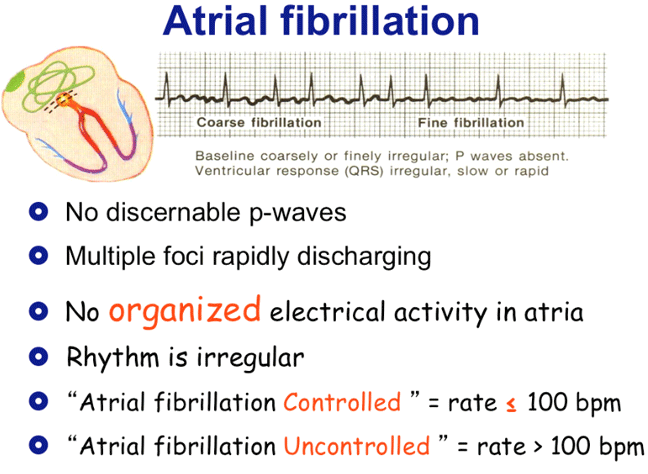| November 2 - November 6: Introducing the 1st Degree AV Block and Premature Ventricular Contractions (PVC) OBJECTIVES: Be able to correctly indentify and interpret a 1st degree AV block Be able to correctly identify and interpret the premature ventricular contraction (PVC) Be able to correctly identify and interpret all arrhythmias covered in class up to this point Class, Please download the EXAM FIRST. We are working through MOST Exam questions in the YOUTUBE video lectures. Click Here to Download Exam 3 Part D due Friday November 6 by 12 Midnight Note to Class: There are 2 Youtube Videos with this Week Please download Worksheet #1 and put your answers on the Exm CLICK this link and PRINT Worksheet #2 Please continue right into the EKG PVC YOUTUBE lecture video. |
||||||||
| 1st Degree AV Block | ||||||||
 |
||||||||
| NOTE: In the interpretation always state the underlying rhythm. For example, the rhythm above would be interpreted this way: NSR with a 1st degree AV Block |
||||||||
| Premature Ventricular Contractions | ||||||||
 |
||||||||
| More PVCs and How to Interpret | ||||||||
 |
||||||||
| Interpretation: Example: NSR with Unifocal PVCs (4th and 8th complexes) | ||||||||
 |
||||||||
| Interpretation: NSR with Multifocal PVCs (5th and 10th complexes) | ||||||||
 |
||||||||
| Interpretation: Sinus Tachycardia with Unifocal PVCs (7th and 8th complexes) | ||||||||
 |
||||||||
 |
||||||||
| With SA Block the R-R interval measurement is within plus or minus 2 small boxes. Here is how you report a rhythm with a sinus block: NSR with a Sinus Block. Note how you do NOT have to state where the block is. | ||||||||
 |
||||||||
| With SA Arrest the R-R interval measurement is greater than plus or minus 2 small boxes. Here is how you report a rhythm with a sinus arrest: NSR with a Sinus Arrest. Note how you do NOT have to state where the arrest is. | ||||||||
 |
||||||||
| Note the Different Names of Junctional Rhythms, All determined by Heart Rate | ||||||||
 |
||||||||
| Below are some examples of Junctional Rhythms with Hidden 'P' waves, Inverted 'P' waves, and 'P' waves after QRS complex | ||||||||
 |
||||||||
| Review: Premature Atrial Contaction (PAC) | ||||||||
 |
||||||||
 |
||||||||
| CLASS, REMENDER YOU REPORT THE UNDERLYING RHYTHM, RATE, P WAVES, PRI AND QRS TO THE LEFT (i.e., BEFORE) OF THE PAC! THEN STATE WHERE THE PAC IS; IN THIS CASE IT IS THE 7th COMPLEX. | ||||||||
| Paroxysmal Rhythms Review | ||||||||
| Paroxysmal means sudden onset. In class, whenever you see a rhythm 'suddenly' get significantly faster (100 b/min or faster) this is a paroxysmal rhythm. For class, we will ONLY identify a paroxysmal rhythm when we see it (like below). Often times our textbook author will say this is a 'paroxysmal rhythm', meaning the author wanted you to know it suddenly happened. | ||||||||
| For the interpretation. Interpret a paroxysmal rhythm like TWO rhythms. Interpret the FIRST rhythm and then the Paroxysmal rhythm. Interpet like below: NSR into paroxysmal atrial tachycardia. | ||||||||
 |
||||||||
| With atrial flutter the 'P' waves are 'flutter' waves. The PRI is indeterminate. Note the 'Flutter' or 'F' waves. They often look like a 'saw tooth' as well. Baseline is absent. Report the F wave to QRS ratio. If not a consistent ratio it is called Atrial Flutter with Variable AV conduction (as seen above). | ||||||||
 |
||||||||
| Exam 3 Part D: Click here to get questions: Exam is due by 12midnight on November 6. No late papers accepted. | ||||||||
|